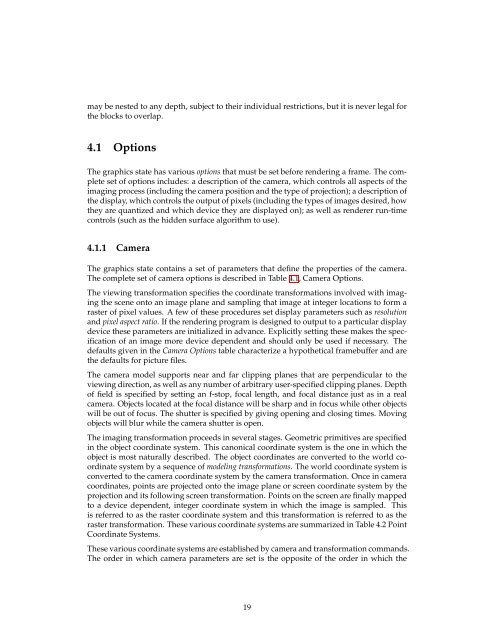The RenderMan Interface - Paul Bourke
The RenderMan Interface - Paul Bourke
The RenderMan Interface - Paul Bourke
- No tags were found...
You also want an ePaper? Increase the reach of your titles
YUMPU automatically turns print PDFs into web optimized ePapers that Google loves.
may be nested to any depth, subject to their individual restrictions, but it is never legal for<br />
the blocks to overlap.<br />
4.1 Options<br />
<strong>The</strong> graphics state has various options that must be set before rendering a frame. <strong>The</strong> complete<br />
set of options includes: a description of the camera, which controls all aspects of the<br />
imaging process (including the camera position and the type of projection); a description of<br />
the display, which controls the output of pixels (including the types of images desired, how<br />
they are quantized and which device they are displayed on); as well as renderer run-time<br />
controls (such as the hidden surface algorithm to use).<br />
4.1.1 Camera<br />
<strong>The</strong> graphics state contains a set of parameters that define the properties of the camera.<br />
<strong>The</strong> complete set of camera options is described in Table 4.1, Camera Options.<br />
<strong>The</strong> viewing transformation specifies the coordinate transformations involved with imaging<br />
the scene onto an image plane and sampling that image at integer locations to form a<br />
raster of pixel values. A few of these procedures set display parameters such as resolution<br />
and pixel aspect ratio. If the rendering program is designed to output to a particular display<br />
device these parameters are initialized in advance. Explicitly setting these makes the specification<br />
of an image more device dependent and should only be used if necessary. <strong>The</strong><br />
defaults given in the Camera Options table characterize a hypothetical framebuffer and are<br />
the defaults for picture files.<br />
<strong>The</strong> camera model supports near and far clipping planes that are perpendicular to the<br />
viewing direction, as well as any number of arbitrary user-specified clipping planes. Depth<br />
of field is specified by setting an f-stop, focal length, and focal distance just as in a real<br />
camera. Objects located at the focal distance will be sharp and in focus while other objects<br />
will be out of focus. <strong>The</strong> shutter is specified by giving opening and closing times. Moving<br />
objects will blur while the camera shutter is open.<br />
<strong>The</strong> imaging transformation proceeds in several stages. Geometric primitives are specified<br />
in the object coordinate system. This canonical coordinate system is the one in which the<br />
object is most naturally described. <strong>The</strong> object coordinates are converted to the world coordinate<br />
system by a sequence of modeling transformations. <strong>The</strong> world coordinate system is<br />
converted to the camera coordinate system by the camera transformation. Once in camera<br />
coordinates, points are projected onto the image plane or screen coordinate system by the<br />
projection and its following screen transformation. Points on the screen are finally mapped<br />
to a device dependent, integer coordinate system in which the image is sampled. This<br />
is referred to as the raster coordinate system and this transformation is referred to as the<br />
raster transformation. <strong>The</strong>se various coordinate systems are summarized in Table 4.2 Point<br />
Coordinate Systems.<br />
<strong>The</strong>se various coordinate systems are established by camera and transformation commands.<br />
<strong>The</strong> order in which camera parameters are set is the opposite of the order in which the<br />
19















